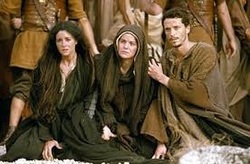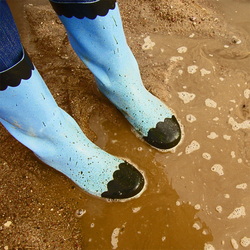|
|
 If you think about it, the week we now call Holy takes us through the full expression of human emotion. The week begins with cheers and adulation, rings in with palm branches and children’s songs then moves to betrayal and abandonment to injustice and suffering and finally towards hope. What we have in the span of one week then, on the liturgical calendar, is an invitation into the darkness. For some of us we are relieved to finally have a season when our questions are valid, when our doubt makes sense, when our grief finds a home and we are not ostracized at our reluctance to celebrate the goodness of God in pithy unweighed theological statements like bumper sticker faith. For those of us who struggle in life lived with happy, clappy resurrection folk, who need a home for our lament, the cross allows us the space to ask, “Where are you God?” In fact, that’s exactly what Jesus asked, suffering as he was that day, life ebbing away on the rock of Golgotha. It is to Jesus I cling. It is to the story of the one who willingly suffered and died that I am compelled. It is to the one who prayed, “Father, take this cup from me,” who opened his eyes to find the cup still there and who drank deeply that I am drawn. If the truth be told, I am not sure I have reconciled to the God that allowed such agony to occur to his own son, to God’s own self, to lowly broken creatures like me, just trying to do our best in this world; why does such pain need to be known. This year as I walk through the Lenten season and into Holy Week, I am clinging to Jesus like Mary did, hoping, trusting, believing he will make some good out of all the pain. I need her strength, I need her courage, I need her understanding of suffering redemptive. As I walk through the darkness I am aware that this year it is not a mere liturgical season but the reality of my own life as not many weeks ago I stood over my own precious child—a nephew—gone too soon from us for reasons that are senseless and tragic. Like Mary, I anointed him with my tears, and I stayed with him until the end and I gave him back to God. It is in these moments of unspeakable agony when we, like Jesus, wonder where God can be found. We wonder how it is that we will make it through, and once more it is Jesus from the cross, thinking of Mary, and perhaps all of us who shows us the way. “When Jesus saw his mother and the disciple whom he loved standing beside her, he said to his mother, ‘Woman, here is your son.’ Then he said to the disciple, ‘Here is your mother.’ And from that hour the disciple took her into his own home” (John 19.26 ,27). Jesus knew his mother and his friends, he knew that we would have to go on, he knew that life is hard and tragedies happen and the world is blood soaked and broken. Jesus knew for those he loved life would continue, the sun would rise, the water would need to be drawn, the families would need to be fed, the laundry would pile up on the floor. Jesus knew what it was to suffer, to face the darkness and to feel as though God had abandoned you. He knew what it was to believe God could not hear your cries, had left you in your pain and Jesus knew, in those moments wrought with grief and loss, confusion and fear God could be found in the arms of someone who loves you, wrapped around you, bearing you up. In our sorrow, as we weep, as we struggle to find legs to stand, to remember to pay the phone bill and make grocery lists, as we remind ourselves to breathe in and out, we hold the hand of the one whom Jesus gave us, we lean in and we bear down and we remember in our loss we are connected, we are bound to Jesus and to each other, and in our bond God is found. Jesus showed us from the cross, this is how we make it through.
1 Comment
 John 9.1-41 As much as we love and appreciate this Jesus— the one who walked the cobblestone streets of Phoenicia and slept in a simple mud and stone house in Nazareth, the one who preached from the high places in Galilee and spent most of his time with fisherman and other common, broken folk; to be sure there are images of this Jesus that are a bit too human for our comfort or taste. An exalted Christ, we can adore, we can venerate, we can honor. A deified Lord we can praise, worship, and look to in troubled times. If we are honest, we spend very little time contemplating this Jewish man of the Scriptures who cried out and sweat blood and wielded a whip in the temple and spat onto the ground to form clay. We don’t have a lot of time for the man who struggled in the wilderness and faced the brutal assault of the enemy. Come to think of it, we don’t have a lot of time for our own struggles these days either, such that it makes perfect sense then that we have turned from this Jesus who walked the earth to focus more on the Christos Victor. Only the discipline of Lent catches us here, it invites us into the wilderness with him and it asks us to struggle through and if we aren’t very careful, something difficult and wonderful will happen out there in the barrenness of the rubble and dirt. We watch Jesus, spit onto the ground, form clay between his strong rugged fingers and apply the fresh, wet earth to our eyes. We wash and emerge from the wilderness of Lent as persons who have gained new sight, able to see things differently than we did before, aware that he is there, with us, through it all and that by his hands even the most unpleasant, unsavory, miserable matters can, become miracles of healing and refreshment. “Open my eyes that I might see visions of love Thou hast for me…” Amen. |
Subscribe Today for Free GiftBLOG
Archives
June 2019
Categories
All
|

 RSS Feed
RSS Feed